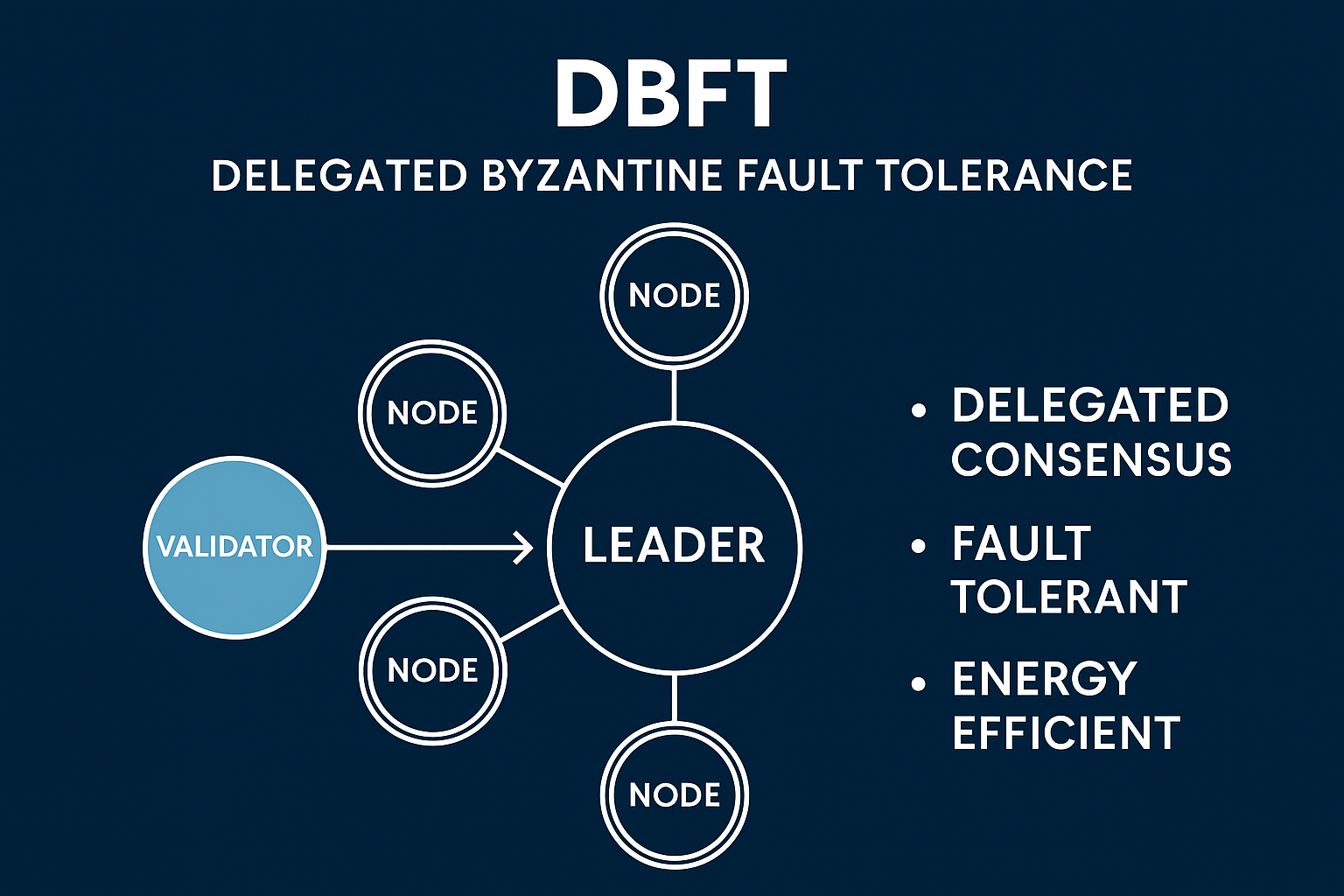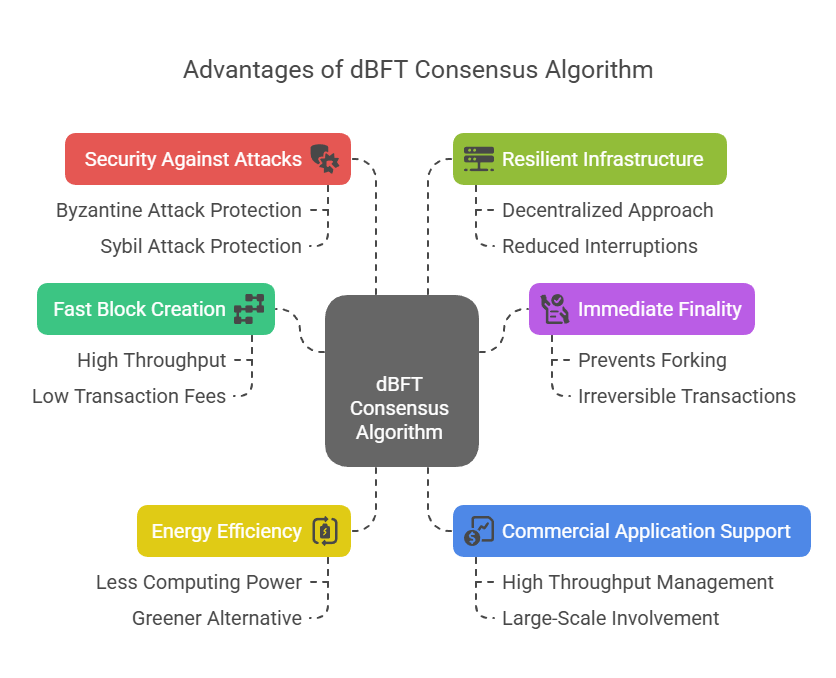DBFT Delegated Byzantine Fault Tolerance

DBFT Delegated Byzantine Fault Tolerance
In order to accomplish network security, dependability, and efficiency, blockchain technology mainly uses a consensus technique called Delegated Byzantine Fault Tolerance (dBFT). It was created during the building of the NEO blockchain, which is regarded as China’s first public blockchain project, and operates as a variation of the Practical Byzantine Fault Tolerance (PBFT) consensus algorithm.
Definition and Purpose
DBFT allows a limited number of delegates to participate in the consensus process instead of all nodes to manage blockchain network decision-making. Its fundamental purpose is to ensure network continuity and consensus among nodes, even with dishonest or faulty members. It is a key technological term since it refers to a consensus algorithm that generates a decentralized, safe, and effective decision-making process.
You can also read Decentralized Autonomous Society For Human Co-Operation
How DBFT Works
DBFT uses elected delegates and token holders in a manner akin to Delegated Proof of Stake (DPoS). The procedure can be divided into multiple steps:
Node Roles:
Nodes in the dBFT model have one of two functions:
- Ordinary Nodes (“Citizens”): These are the people who own NEO tokens and use their processing power to exchange and transport data. Regardless of how many digital tokens they own, people can vote for the “bookkeepers” (delegates) they choose to support.
- Bookkeeping Nodes: Also known as “Delegates” or “Consensus Nodes,” these nodes are employed to verify and authenticate transactions on the blockchain of the network. A node must fulfil certain requirements in order to become a delegate, such as possessing a stable and dependable internet connection, a verified identity, the necessary equipment, and 1000 GAS as a stake. GAS is given to delegates as payment for their bookkeeping efforts.
Delegate Selection:
By proxy voting, the larger network community chooses a small number of trusted nodes, referred to as delegates or consensus nodes.
Block Creation and Consensus:
- To form a new block, a speaker is selected at random from among the elected delegates. After developing its own version of a block, or group of data, this speaker suggests to the other delegates that it be added to the blockchain.
- Two-thirds of the selected delegates must validate and approve a new block before it can be added to the blockchain. To create new blocks, the chosen bookkeepers use the Byzantine Fault Tolerance (BFT) method to come to an agreement.
- The suggested block is rejected and a new random speaker is chosen to continue the procedure if the two-thirds validation criterion is not reached.
Transparency:
All network transactions can be tracked and recorded by elected delegates, who can also exchange and compare suggestions.
Fault Tolerance and Security
Due to its Byzantine fault tolerance, dBFT can continue to operate even if some nodes behave maliciously. To identify and control tainted nodes or erroneous block proposals:
- The block proposal is compared by the delegates in their separate forms.
- Two-thirds of the delegates will consent to the invalidation of a corrupted block and the removal of the randomly selected speaker who submitted it. This strategy isolates corrupted nodes to protect the blockchain from their malicious activity.
- For network integrity and reliability, dishonest or untrustworthy delegates are checked, modified, or voted out.
Advantages of DBFT

Advantages of DBFT
Compared to other consensus algorithms like Proof of Work (PoW) and Proof of Stake (PoS), dBFT has the following significant advantages:
- Fast Block Creation and High Throughput: It provides high throughput and makes it possible to create new blocks quickly. Low transaction fees and fast confirmation times are made possible by its highly scalable and effective transaction validation.
- Immediate/Total Finality: The blockchain’s promise of immediate and complete finality is one of its primary characteristics. Blocks prevent “forking” or duplicate spending by making transaction data final and irreversible. This is important for applications that require fast, irreversible transactions.
- Energy Efficiency: dBFT’s voting system requires less computing power and is greener than PoW.
- Commercial Application Support: DBFT can serve commercial applications because of its capacity to manage high throughput and large-scale involvement. It is appropriate for a range of financial and business applications.
- Security Against Attacks: It lessens the risk of possible security risks like Byzantine and Sybil attacks. Launching a 51% attack on the NEO network is nearly impossible.
- Resilient Infrastructure: It makes it possible to take a decentralised approach to reducing interruptions brought on by malevolent actions or malfunctioning systems, which makes the network infrastructure more resilient.
You can also read Distributed Consensus Blockchain Importance And Challenges
Disadvantages and Criticisms
Despite its benefits, dBFT has certain drawbacks.
- Increased Centralization: dBFT has come under fire for encouraging a greater degree of centralisation inside the network, which is consistent with its designation as a permissioned consensus mechanism with a “low” degree of decentralisation. Critics point out that NEO is now far more centralised than other cryptocurrency networks because to its significantly fewer number of nodes and the fact that the NEO council owns the majority of its bookkeeping nodes.
- Identity Revelation/Privacy Concerns: Nodes are required to reveal their true identity for the delegate voting process. This lack of anonymity and the tendency towards centralisation mean that dBFT-based blockchains cannot fully ensure privacy.
- Vulnerability to Collusion: Since dBFT is democratic, most validators may collude, compromising integrity.
- Network Halts: The network may be placed on pause if a critical node disconnects or if over one-third of the delegates are inconstantly at odds. For instance, a node disconnecting caused the NEO network to momentarily stop functioning.
The Byzantine Generals Problem
The Byzantine Generals Problem, an abstract problem in computer network maintenance, is the foundation of dBFT. It describes mistakes in a distributed computer network that may occur as a result of malicious or malfunctioning individual nodes. A hypothetical situation where Byzantine generals must plan an attack on a city but some may be dishonest or inept serves to highlight the issue. By requiring a two-thirds majority agreement among trusted delegates to validate transactions and add new blocks, dBFT aims to address this issue by guaranteeing that a consensus is attained even in the event that some nodes are malevolent or flawed.
Examples of Platforms Using DBFT
- NEO: The dBFT consensus was first applied to its blockchain network by NEO, a well-known blockchain platform dedicated to creating a smart economic system.
- Ontology: By adding a “trust” layer to the conventional dBFT architecture, the Ontology Network uses a variant of dBFT to offer high-performance, adaptable blockchain solutions for organisations and enterprises.
- Aelf: Aelf is an enterprise-focused blockchain platform that uses the dBFT consensus algorithm to reach dependable and effective consensus among its network nodes in order to address scalability, security, and governance concerns.
You can also read What Is FBFT? Knowing Federated Byzantine Fault Tolerance
